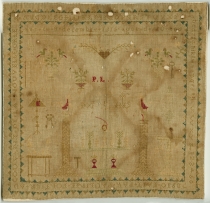Embroidery samplers by young girls are well-known artifacts of the eighteenth and nineteenth centuries, but this one has distinctive features unique to its Louisiana origins. Unlike the outdoor scenes and alphabet rows commonly seen on samplers in England’s thirteen colonies, this one shows Spanish and French influence. The border of the sampler, with the alphabet and the maker’s signature, was a common feature in Spanish embroidery lessons. Similarly, the Catholic church scene hints at young Pauline’s education by the Ursuline nuns of New Orleans. On the altar decorated with flowers and candlesticks, the Eucharist, which Catholics believe to be the body and blood of Christ, is displayed for adoration in a monstrance. Other liturgical paraphernalia are visible on the sides, including an incense censer, a bell, cruets, and a large cross.
For generations, fine needlework was a crucial part of any young woman’s education if she was wealthy enough to devote time and resources to sewing beyond her family’s practical needs. The early New Orleans Ursulines earned a large portion of their operating budget by boarding and teaching the daughters of well-off families, including free people of color. In addition, the Sisters offered daytime catechism classes, and ran the Royal Hospital and an orphanage at the request of the Company of the Indies. The Ursulines’ focus on teaching young women was an innovative mission for an order of nuns. They wanted Louisiana families to be led by good Catholic wives and mothers, and so made sure girls like Pauline were well-informed in their faith. Thanks to the Ursulines’ teaching, colonial New Orleans also enjoyed a high female literacy rate for its time.

